DIY Concrete Patio: Part One
We are very excited to show you the “HUGE” DIY concrete patio project that we took on this year in our backyard. We decided to attempt to do it ourselves, and this was no small patio. We wanted to go big or go home. So, a 450 square feet of patio is what we designed. It took a lot of time to get the project planned out and even more time prepping And once we got closer to actually laying the patio, we knew that we had to get some professional help. Being a DIYer it’s hard to ask for help, but we knew this was too big of a project to completely go solo.
We started by asking friends if they knew any concrete professionals. Just my luck, a friend of a friend is concrete work on the side of his day job. (I recommend getting a few references, before going forward with a project especially when working with friends…)
The great news was, that Dallin (our concrete guru) was willing to bring all the tools (besides the mixer which we rented) coach us through the prep work, and teach me while we installed the patio so that I could attempt to do this on my own in the future. Which was a great experience for future reference!
Helpful Tips for DIY Concrete Patio Prep Work
- Have the whole yard blue staked.
- Make a plan of what it will look like and what things you need to do to get the area ready.
- Layout your plan on the ground with spray paint. Make sure your corners are square and perpendicular to adjacent buildings.
- Plan for at least a 2% grade drop to help water travel away from the house. Ours ended up being a 7″ drop across a 23.5′ patio. It worked perfectly with the grade of the grass.
- Dig out the patio to the depth of 5-7″. A total of 4″ for the concrete and 1-3″ for the gravel (the depth of gravel depends on the type of soil that the patio will be on). Ours was a total of about 5-6″ because our soil was so hard to begin with.
- Don’t over dig. Dig out only what you have too. Keep the ground below the gravel layer undisturbed.
- Plan on where to place the extra soil. We had garden boxes and a large garden area for all the extra soil. It was about 15 cubic yards of soil that we moved. That is over 125 wheelbarrow loads or dirt with over 40 man hours to move the dirt all spread out over a period of a month and a half. ( I told you this was a huge project!) This was the biggest part of the project.
- Rent equipment to dig it out, if you have the room to get it back to the area and if you know you don’t have any utility conflicts. We decided to hand dig ours because of irrigation and phone lines that crossed down the middle of the patio.
- For curved forms, rip a 1/2″ sheet of plywood in strips 3 1/2″ wide. This was to match the 2×4 form that we used on the straight forms.
- Use only duplex nails on the forms, on the outside of the pouring area. We had a couple of areas that chipped off because the head was slightly in the concrete when the forms were ripped out. OOPS!
- Rent the largest mixer that you can. We rented a gas powered mixer from the Home Depot for $85/day. It was worth every penny!
- Hire extra helpers when moving the concrete bags and for mixing the concrete.
- Lift with your legs not your back. The last thing you want is back pain at the start of a project like this.
- Wear masks (We love 3M’s masks) while mixing the concrete . You don’t want to get the concrete dust in your lungs.
Tools Used for Prep Work
- Hammer Drill (drilling holes in adjacent concrete foundation, for anchor rods)
- Screw Drill
- Hammer
- Circular saw (for form work)
- Heavy Duty Wheelbarrow (for moving dirt, gravel and bags of concrete to project site)
- Heavy Duty Dolly
- Spade Shovel
- Sledge Hammer
- Long Level
- Long Straight Board (for leveling the grade of the patio)
- Sharpie Marker for marking on form where control joints will be cut in.
- Sting for laying out the edges.
- String Bubble Level
- Large Tarp to cover any bags of concrete in case of a storm.
Materials Used for Prep Work
- 2×4’s (form work)
- 18″ Grade Stakes (12″ apart on the curves and 24″ on the straight forms)
- Duplex Nails
- Deck Screws ( for some form work)
- Expansion Joint Board (for up against the house)
- Spray Paint (laying out the design)
Laying Out the DIY Concrete Patio Design
Here is the first edge that I defined when We built the garden boxes. We used deck screws and 16″ stakes to hold in this form that the garden boxes sat on. It drops 7″ from the house, to give 2.9% drop. We didn’t want any chance of water flooding in the house during a rain storm. The grade also worked out perfect to match up with the existing lawn area. (at least in that we got lucky!)
|
|
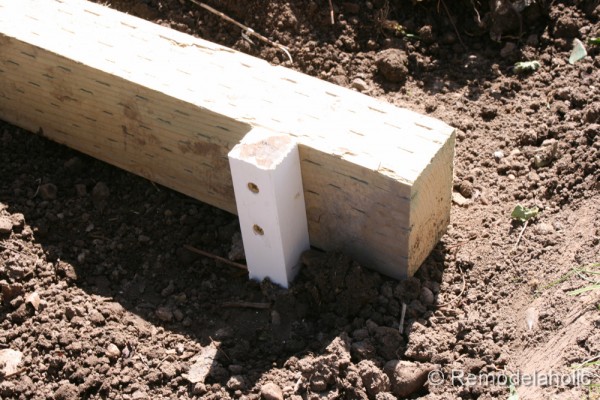 |
We set rebar stakes in the ground at the center points of the curved walls. If you mark the sting with tape at the radius point, you just swing it around and paint at that point for a nice smooth curve.
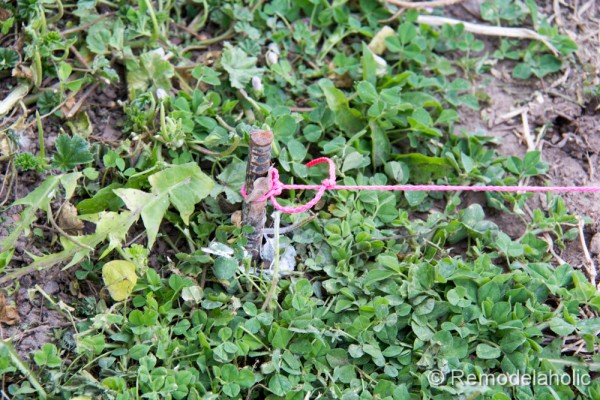 |
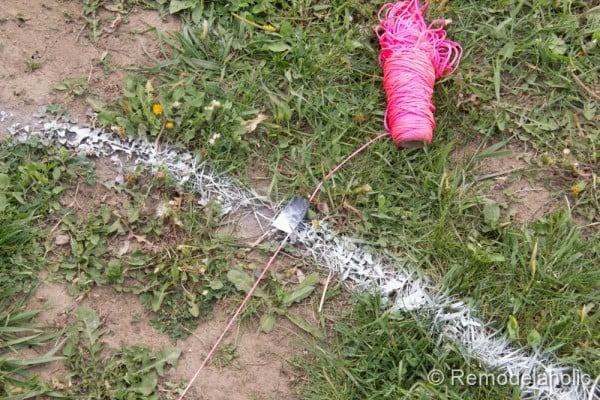 |
We worked the design around an existing pear tree.
 |
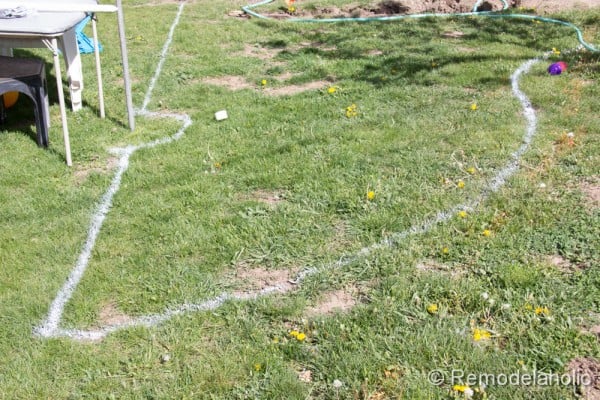 |
Digging Out the Patio
Once the patio was painted on the ground and the utilities were Blue Staked, we were ready to dig. We used most of the sod in the area, to patch some bald spots throughout the yard, then we filled in the garden boxes will all the extra soil.
Here is my brother building a small wall to hold our extra soil for the other garden area. We used the free wood that we got from my uncle when we built the garden boxes.
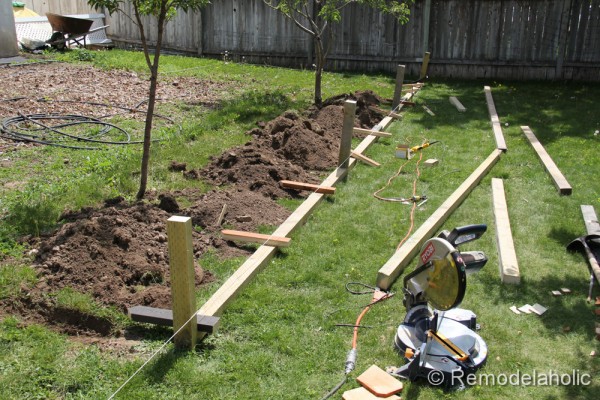 |
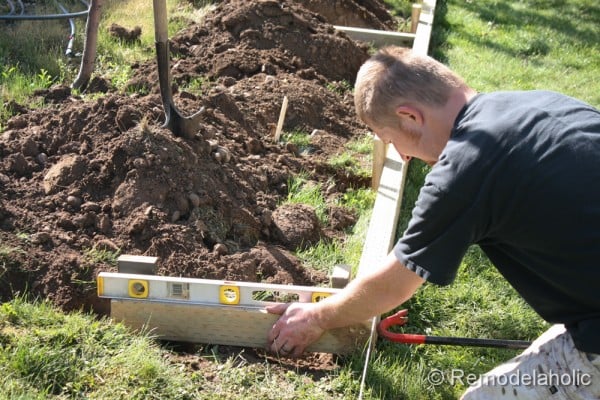 |
 |
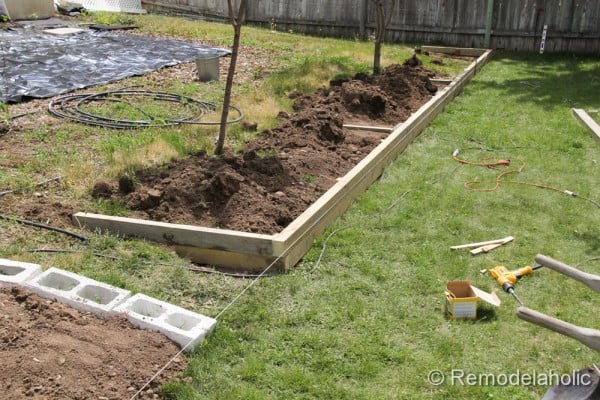 |
There was a weird existing footing, from who knows what, that we had to break up and move. We saved all the pieces to use for walkway of stepping stones some where else in the yard. Breaking up concrete is a great way to smash out any frustrations.
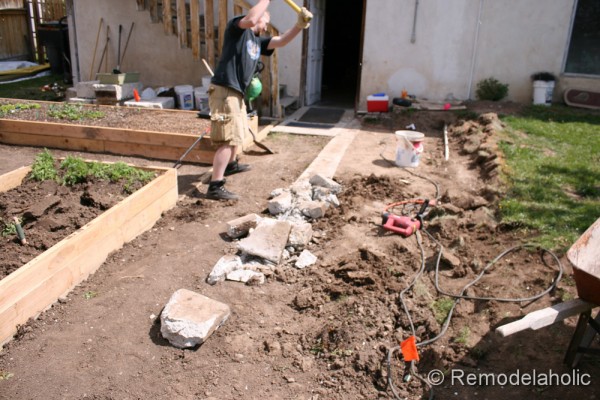 |
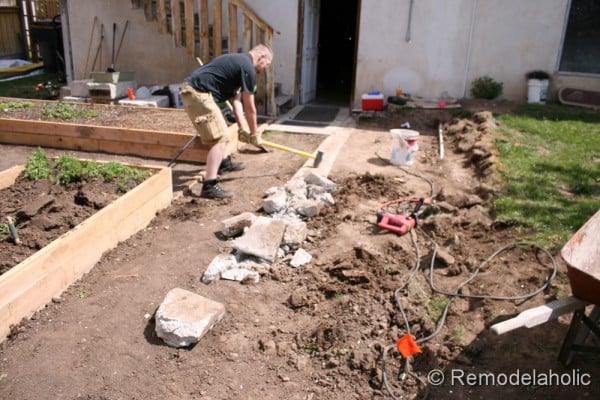 |
Here is the garden starting to be filled in and leveled out.
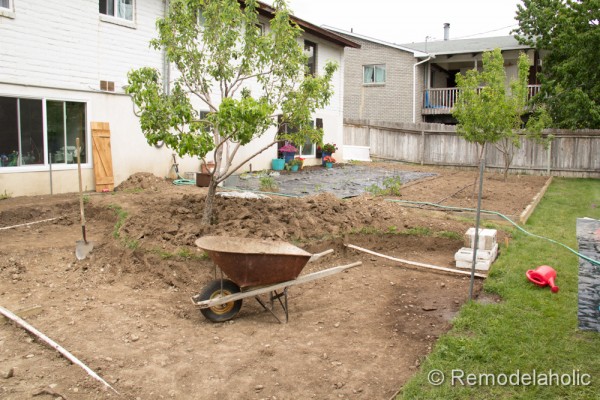 |
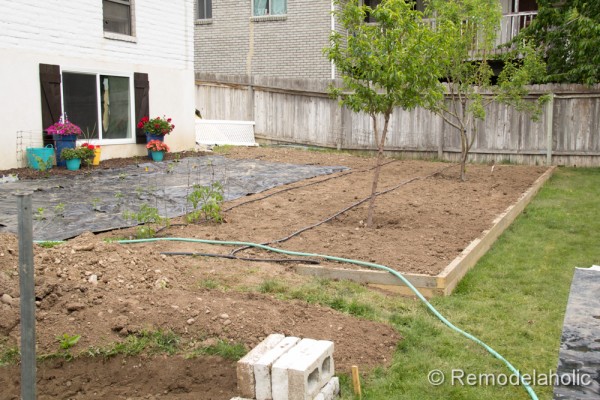 |
We used a long straight board with a level on top, to level the grade from the side form with the garden boxes. We didn’t have to do any calculations because it was already done when we set the form. All we had to do was keep the grade level perpendicular from the form and everything would drain properly.
We did run into the sprinkler lines and had to redirect them under the patio in a 4″ sleeve.
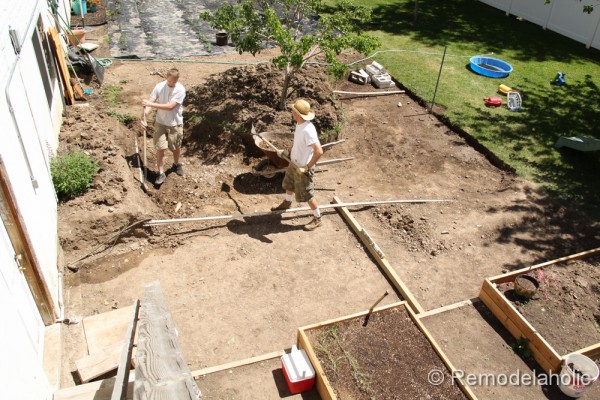 |
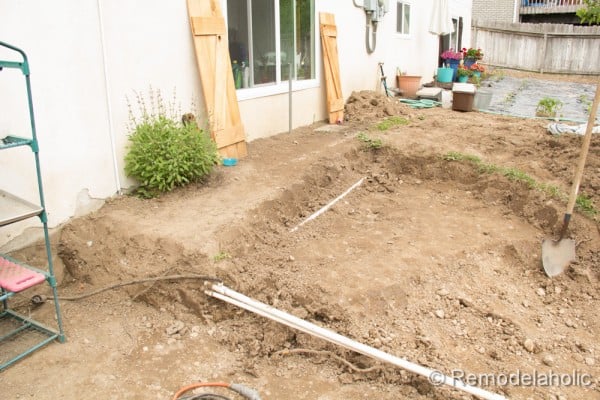 |
Here is the trench that we dug out for a 4″ sleeve. It was pretty easy digging other than the small planet that I found right in my way. We decided to keep the boulder so we can do something fun with it in our flower garden.
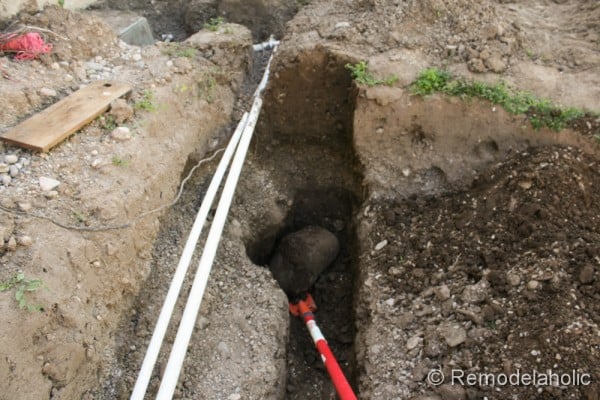 |
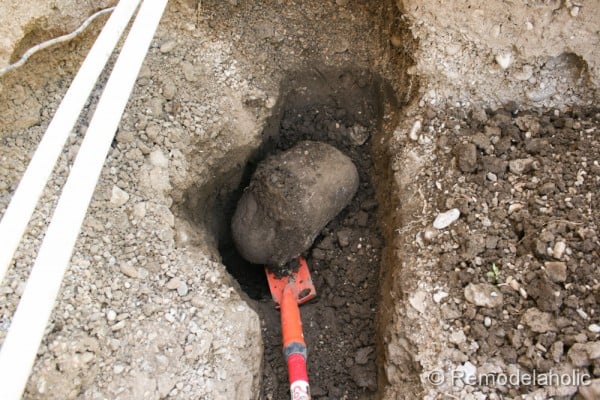 |
This is the sleeve being buried and ready for the new sprinkler lines to slide into.
There was a little bit of a challenge when it came to hooking the pipes back up to the right watering zones. We managed to pull it off though.
Now that all the sprinkler work was fixed and out of the way, we were able to get the forms in place. Dallin, my new concrete professional buddy, came over to help set the forms and make sure that the grade was good before we brought in the gravel base.
We weren’t too concerned with the exactness of the radii around this edge, because we knew that the future seat wall from Pavestone was going to cover it up. If there wasn’t going to be a wall there, we would have taken more care to get the radii to look just right.
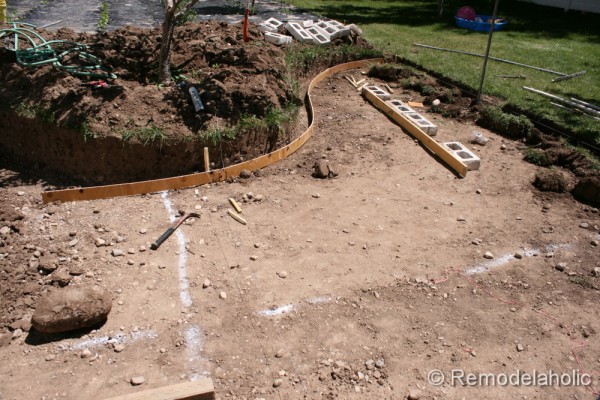 |
 |
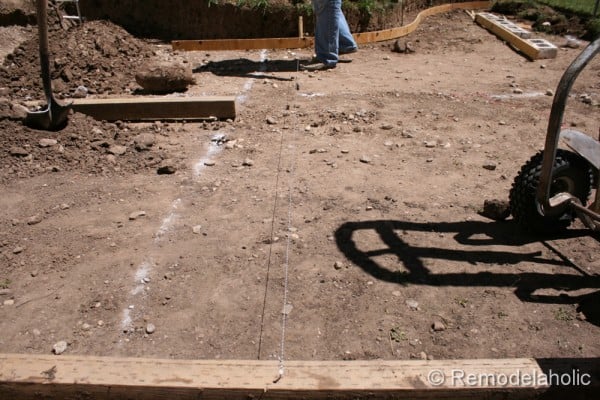 |
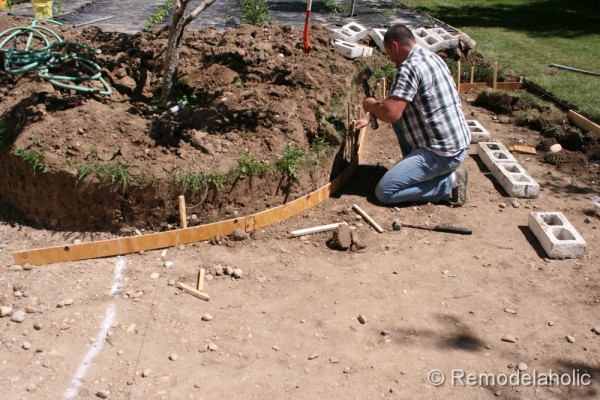 |
When staking a form along a curve you need to have the stakes spaced closer together, to hold the shape of the form. These were about 12″ on-center.
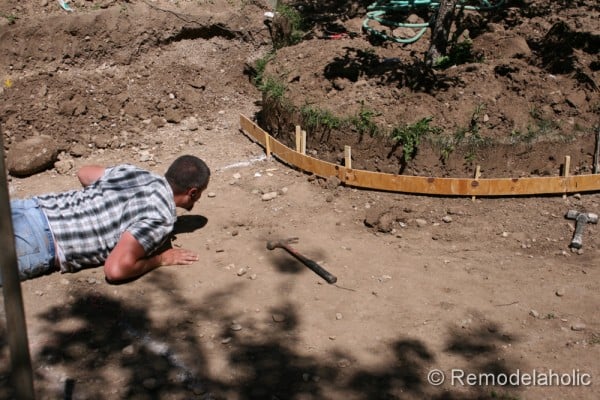 |
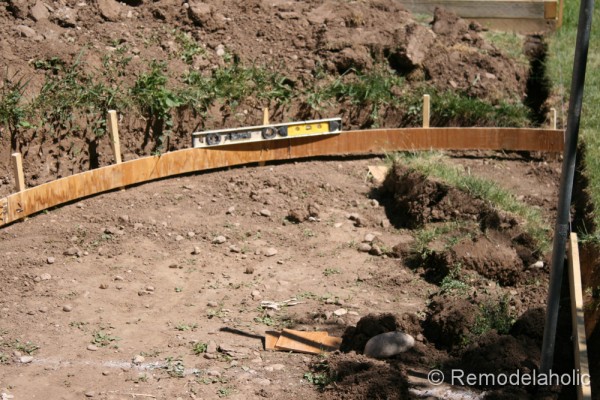 |
We decided that now was a good time to raise the sprinkler valve box. It was low to begin with. Also here is a picture of a sage plant that survived a transplant in the heat.
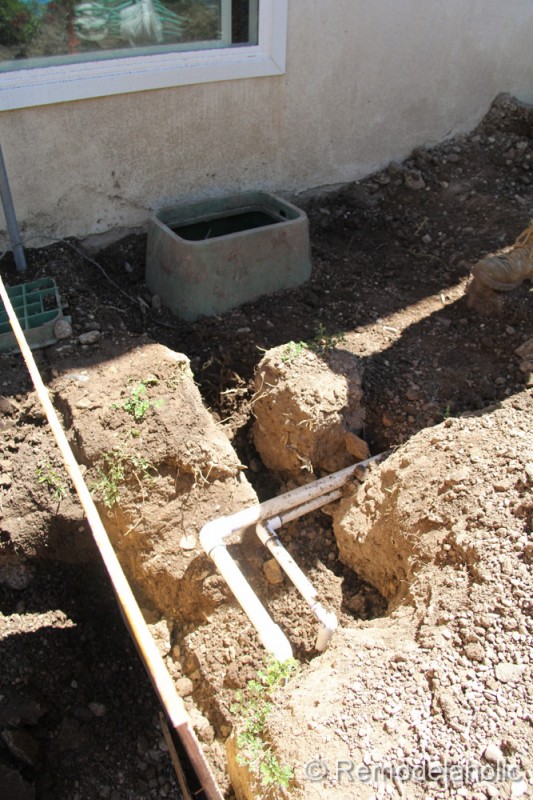 |
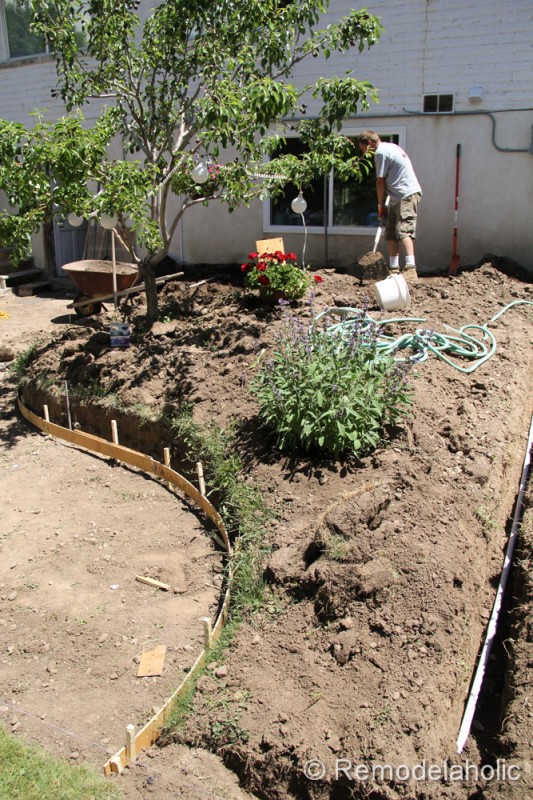 |
Here you can see the area where the soil was removed away from the house. By removing the soil from the house we exposed the wires that go to the sprinkler valves from the sprinkler clock. We will be patching the wall and hiding the wires in the future.
One thing what worked in our favor was that the new patio will be sitting on the foundation of the house for added support. So hopefully, the chances of the patio settling away from the house are very slim.
Here is where we started spreading out the gravel. We purchased 2 yards of pea gravel from a local landscape material company. It only took about and hour to spread the gravel level across the patio. It ended up being around 1″-2″ thick. , Dallin said that it didn’t have to be any deeper than that, because our soil was so hard to begin with. That was good news because we were running out of places to put the soil.
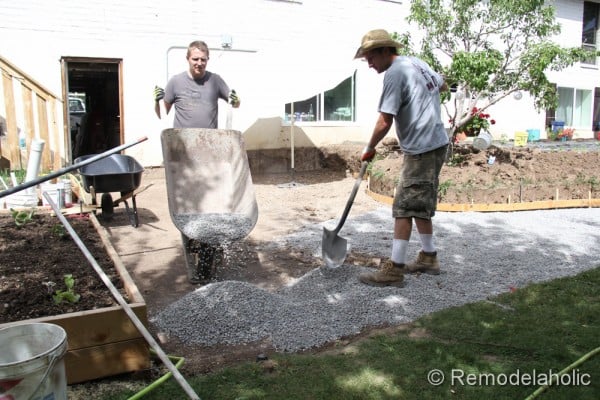 |
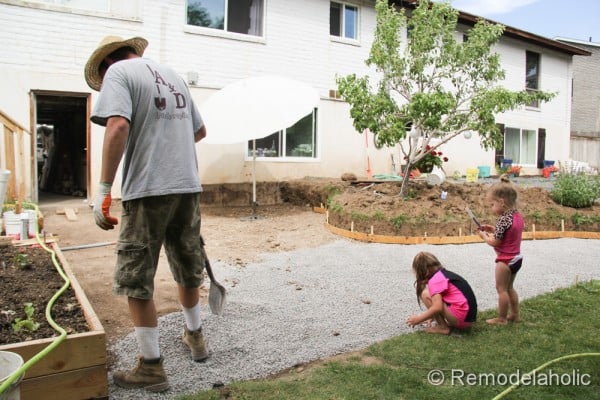 |
There were just a couple of straight form edges that I had to finish at this point.
Up against the house we tied into the existing foundation and added a expansion joint between the house and new patio. The rebar anchors will help keep the patio from sliding away from the house over time.
All we had to do was drill a hole 4″deep in the foundation and hammer in the 12″ long #4 rebar (1/2″ thick rebar).
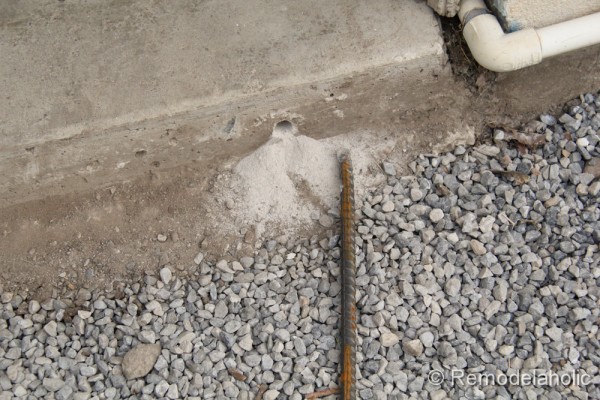 |
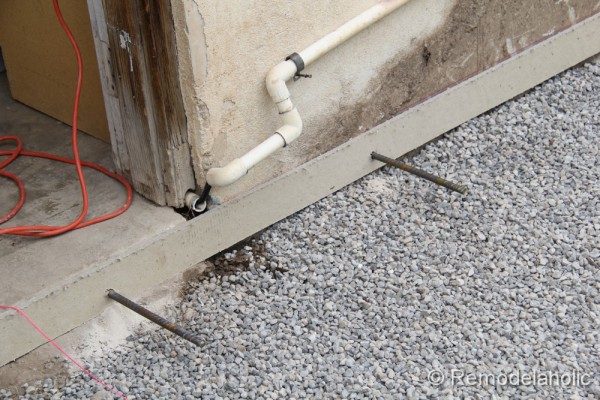 |
Once that was in place the forms were complete. We marked the wall where the control joint was going to be and on the forms on the sides. One thing to keep in mind with the control joints is, make the joints no bigger that 10′ apart. The control joints force the concrete to crack in that joint (hopefully!).
No we were done with the prep work and ready for concrete!
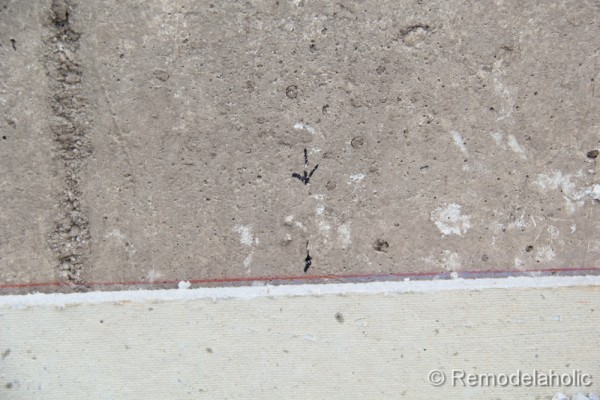 |
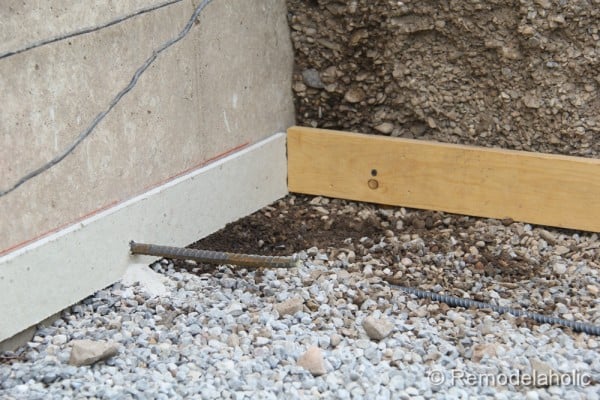 |
Quikrete Concrete Delivery Day
This was an exciting day, when we finally got the concrete delivered. We used the Quikrete quantity calculator online to figure out how much we would need for our 450 square foot patio. We were told by Quikrete that it would be best to get 80 lb bags to get the job done. Typically they sell 50 lb bags at the hardware store, but we were able to get the contractor size bags. They were heavier, but you dealt with less bags. For the grand total of bags we had 275 bags, delivered on 6 1/2 pallets. That is a LOT of concrete people!
Here I am unloading the truck. This was my first time using a forklift. I was a little nervous at first, then I got the hang of it by the last pallet of course. We had to rent the forklift ourselves to get it unloaded.
Big power tools are cool!!!
Once they were unloaded on the driveway, we had to carry them to the backyard in wheelbarrows and heavy duty dollies. It took about an hour with 6 guys. Not too bad! We were very grateful for our friends willingness to help us out. It would have taken me about six hours on my own to do it, and then my back would have been gone, and a patio would never have happened… (p.s. there was not other real access to the backyard, so we couldn’t just forklift it back there!
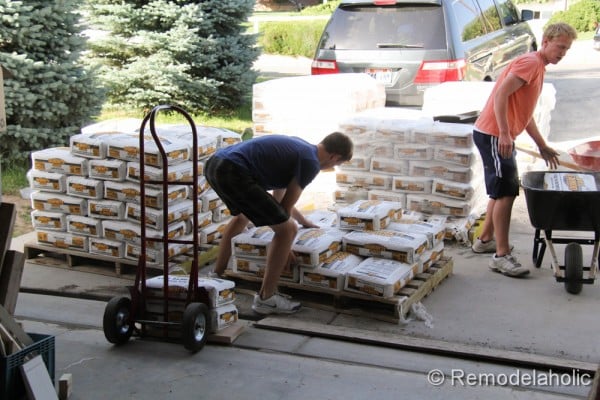 |
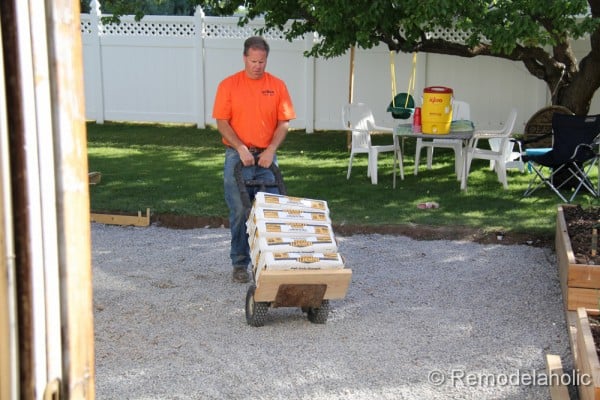 |
We placed half of the bags on the grass and half on the gravel. This way we didn’t have to damage the grass too much with all the weight. Each pallet weighted over 2000 lbs.
Just in case it rained, cover it up with a huge tarp.
So that is all the prep work that we did before we could start pouring the DIY concrete patio. Stay tuned for part two to learn how we mixed and poured the patio in one back-breaking day (of course, just our luck, it was the hottest day of this year!).
Click here to read part 2 of the DIY concrete patio: mixing, pouring, and finishing.
Thanks to Quikrete who sponsored the concrete portion of this project. All other supplies and materials were purchased by us, all opinions are our own.
I am the husband of the amazing Cassity of Remodelaholic. I love to problem solve and to design and build things inside and outside the house to make life better. I am a professional Landscape Architect by trade and love the outdoors.

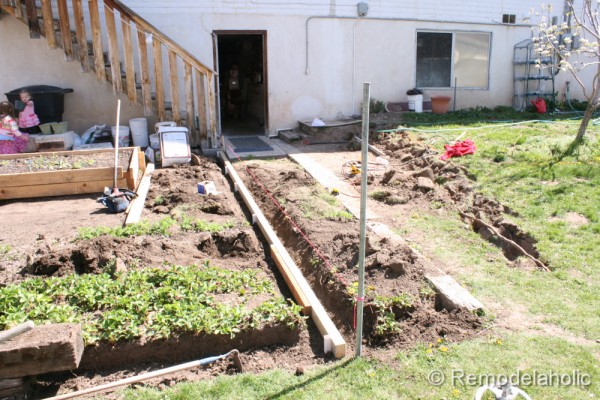

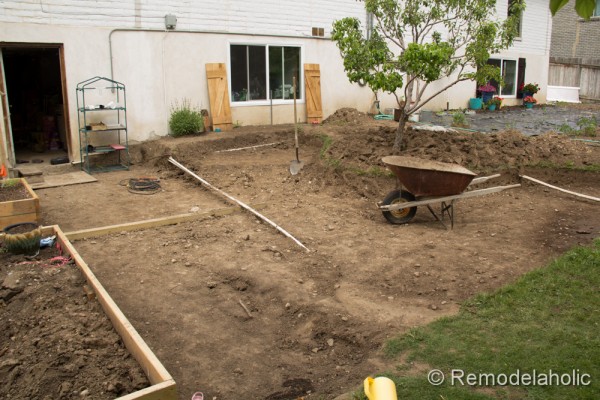

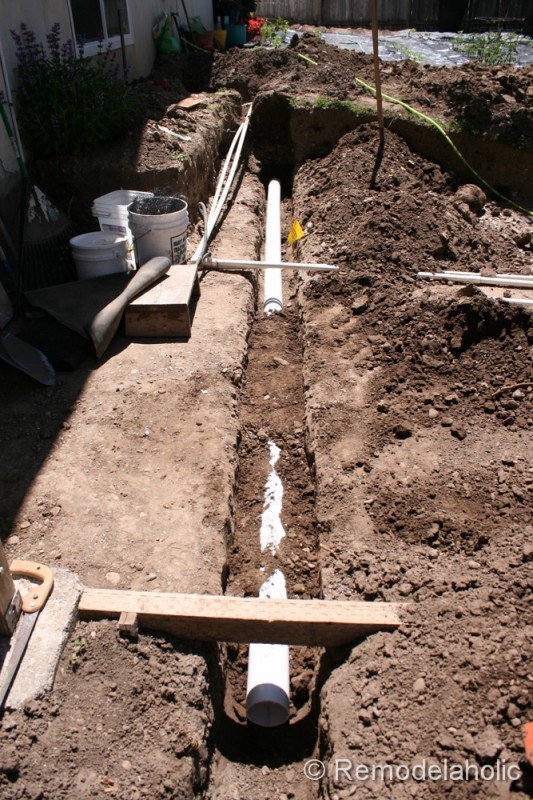


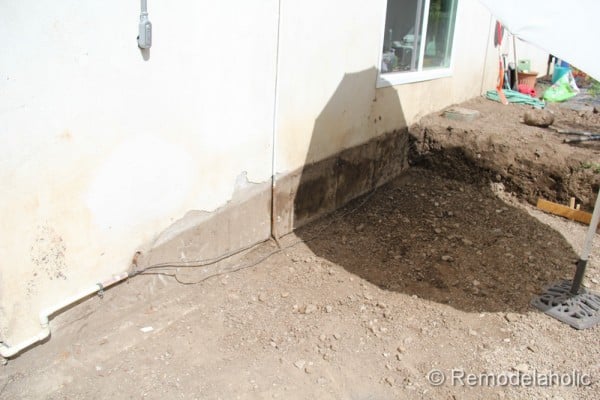
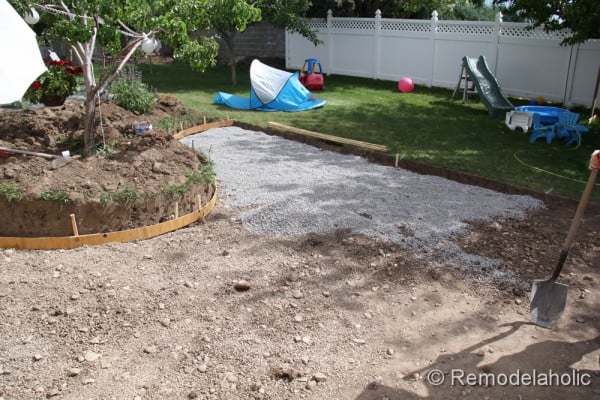
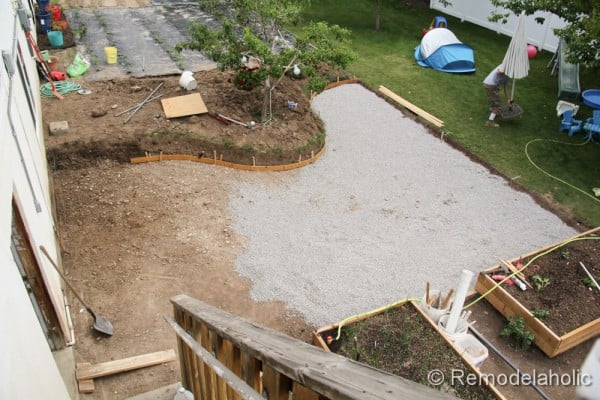


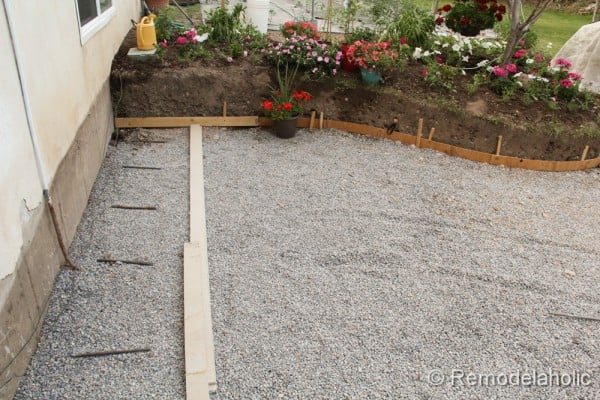
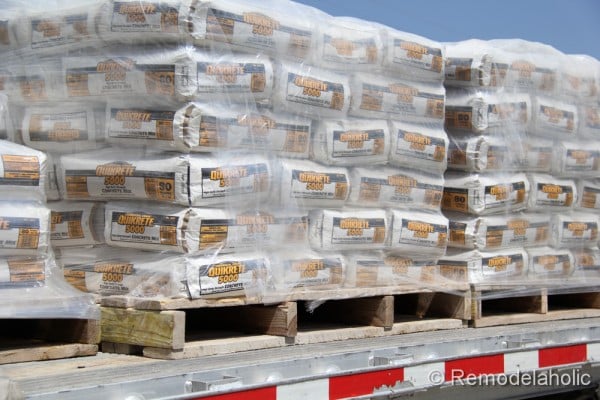
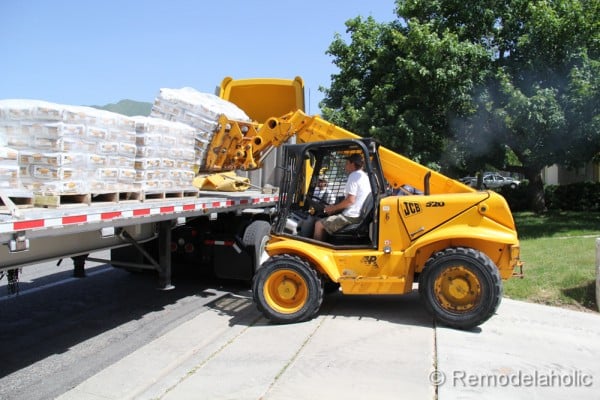
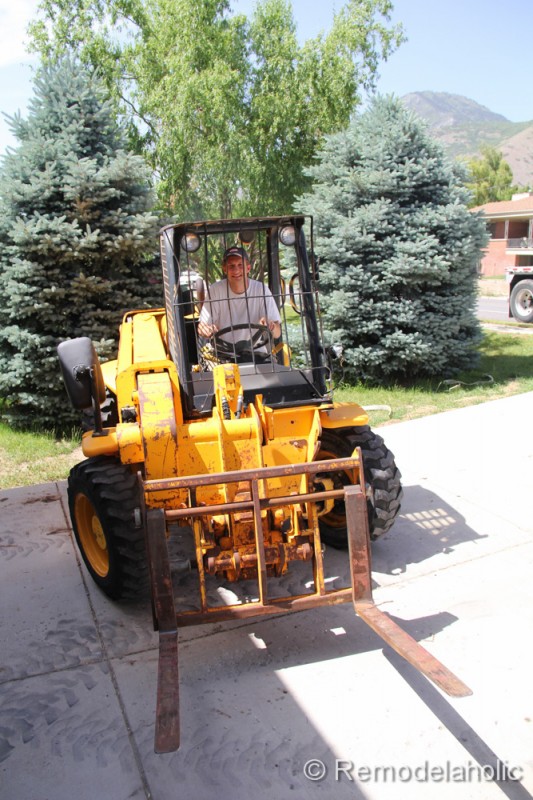
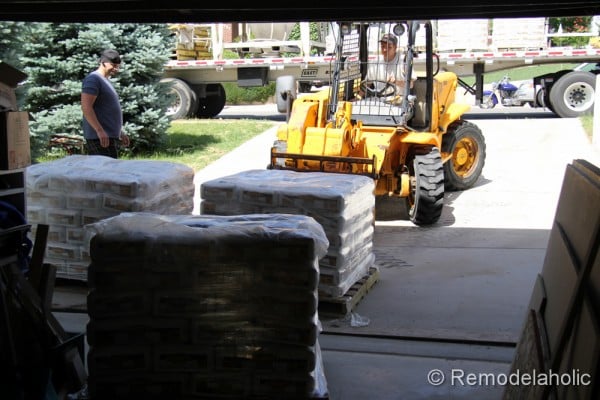
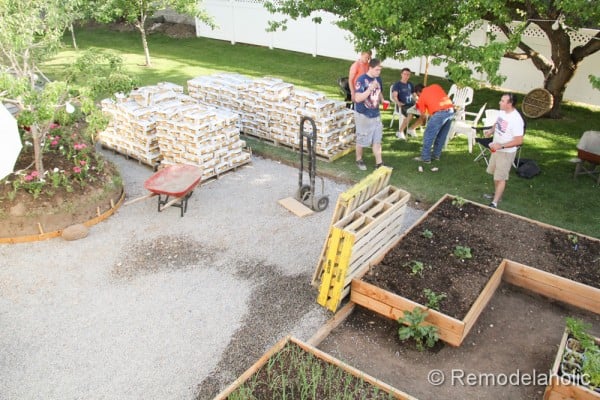
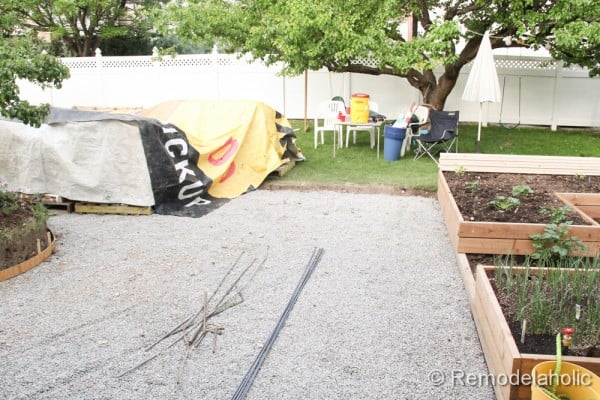

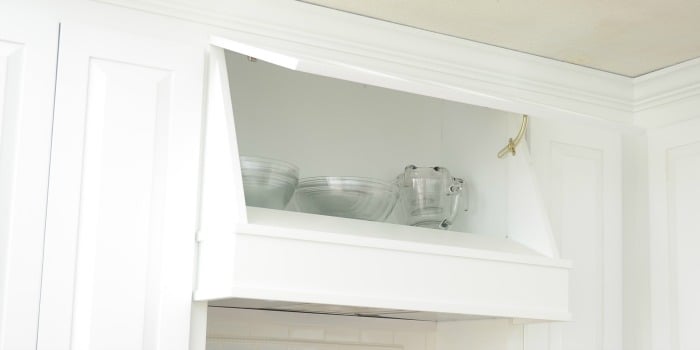




Oh Lord! Kill me now. I can’t imagine this job. Hubby and I’ve always did the prep work but we let the concrete guys haul our the premixed concrete in a big truck. 😉 Love the raised beds.
Jake’s a Girl
oh my goodness!!! I’m thinking of putting a patio in my backyard and am a huge DIY’er, but that project is WAY more than this 50+ year old woman could handle, lol. Think I’ll leave the cement to the big boys. 🙂
That’s a huge job! I’m impressed.
Just wondering if you got a quote from a concrete company on how much it would have cost to have a pumping truck deliver your concrete? I totally get the DIY concept, but that is a LOT of concrete to haul, mix, and pour! Those trucks have long hoses to be able to get into your backyard to pour for you. Curious if it was just totally worth it to DIY due to cost…
Regan, I didn’t get a quote, but I talked to my concrete friend and he said that it would cost thousands of dollars more to have that done. I believe that we saved a lot to do it ourselves, plus I wanted to try it. Everyone thought I was crazy to do it.
Definitely saving this for when we lay our patio next year!
Wow! These DIY concrete patio needs a lot of patience and motivation to do and finish. I admire you for doing this all by yourself. Ian’t wait how the sprinkle system works out with your plants. I’m sure that this will look great. I’m looking forward to the part two of your post.
Thanks for the comment, Rita.
I know this is an old post but I was impressed at the scale of this project. You’ve inspired me to try it on my own.
To answer Regan’s question:
DIY w/ 275 bags. 275x$3.05 / bag = $840 + mixer rental (contractor supply house might unload for free now)
DIY ready mix concrete ~6.5 CY at $125-$150 = $815 – $975
And a whole lot of wheelbarrows or pump truck at about $150-250 per hour on site plus travel and cleanup fees. Plus it will go faster so you’d need a higher skill set to get it installed properly.
Contractor installed,depending on region $2,300 – $3,500. But it is hard to get a company to just come and install a smaller patio in a busy market.
WOW! That is exceptionally impressive to take on as a DIY project of that size! Well done!